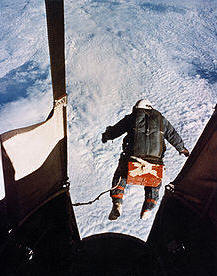|
|||||||||||
|
|
|
|||
|
By Jim Douglas |
||||
 |
August 25, 2010 -
The Red Bull Stratos mission team provided a first look at the
custom camera systems that will record and broadcast Felix Baumgartner's
stratospheric mission in real time and high definition. The details, announced at capsule manufacturing facility Sage Cheshire Aerospace, reveal that capturing a potentially supersonic freefall from the edge of space may be one of the most complex elements of the Red Bull Stratos mission.
But with in-flight
cameras mounted on both the capsule and Baumgartner's space suit, the
unique setup holds potential to provide an almost first-hand perspective
of what it's like to bail out in near space and freefall 23 miles above
Earth. When current record-holder USAF Col. (Ret.) Joe Kittinger jumped from 102,800 feet (50 years ago this month), his team used spring-wound motion picture cameras warmed by hot-water bottles to document his freefall.
Red Bull Stratos
will use high-definition video cameras and ultra-high-definition 4K
digital cinematography cameras so powerful that the challenge will be
keeping them cool in an environment where the air is too thin to wick
away their prodigious heat.
Ken Arnold, the
man who engineered Kittinger's Project Excelsior camera systems,
remembers those pioneering jumps vividly. "I look at the pictures quite
often and the one that I'm most proud of is the one where he goes out
the door," Like Arnold, Jay Nemeth, the Red Bull Stratos Director of Photography and founder of FlightLine Films, is keenly aware that the mission camera systems he has developed hold responsibility for providing research data.
He notes, "The
better the quality of the images, the more we give the scientists to
look at later and analyze -- the little nuances and details that are
essential in understanding something that's never been done: a man
breaking the sound barrier with his body."
Nemeth also
acknowledges that the complexity of the Red Bull Stratos system is a
"double-edged sword," saying, "We will get much more vibrant footage,
more angles, more coverage; but we also have to cover more failure modes
-- there is much more to go wrong." |
|||
| Kittinger's record breaking skydive on August 16, 1960, from the Excelsior III at 102,800 feet (31,300 m) | ||||
 |
||||
| The Red Bull Stratos moving images main electronics cage, which houses: High-Definition RAM recorders, Camera Control Units, Routers, 3 Video Transmitters, Telemetry Computer, and a sophisticated electrical system to power everything. The cage resides inside a pressurised keg located at the top of the capsule. | ||||
|
The Red Bull
Stratos team of world-leading production experts has equipped the
capsule with nine high-definition cameras, three 4K digital
cinematography cameras and three high-resolution digital still cameras.
Of these, four are space-rated units attached to the exterior base of
the capsule. Another eight are in pressurized housings also on the
exterior of the vessel -- the housings are designed to protect the
sensitive cameras they contain from the near-vacuum air pressure, ice
and extreme heat of the stratospheric conditions.
The remaining
three cameras, although positioned on the interior of the capsule, are
space rated to withstand the atmospheric extremes once Baumgartner
depressurizes the capsule to step out. And supporting all this is a
pressurized electronics "keg" that contains approximately two miles of
wiring. The ensemble capsule camera system will allow Mission Control to
monitor the ascent visually for any signs of pilot decompression
sickness or other safety hazards; record all activity for the benefit of
future scientific research; and provide viewers of the worldwide
broadcast with perspectives of the capsule, the skyscape and Baumgartner
himself.
"We have basically
created a flying video production studio," says Nemeth. "The cameras are
remotely controlled from a station in the Recognizing that a single image can crystallize the power of a moment, the Red Bull Stratos team has made still photography a priority as well. "There's an iconic shot of Joe Kittinger on the cover of LIFE magazine that shows him freefalling against the background of a cloud bank about 15 miles below," Nemeth marvels. "It was taken by an automatic camera mounted on the gondola by National Geographic, a 35 millimeter that was cutting-edge at the time -- but it used film; it wasn't digital. We're so lucky that image survived the journey."
Adventure sports
photographer Christian Pondella, who was brought in as a consultant
early in the still camera system's development to provide input on
lenses and camera mount positions, opted for still cameras with small
bodies yet large resolution, and suggested a 14mm wide-angle lens to
capture Baumgartner's exit from the capsule, as well as a 64-gigabyte
flash card that has a high rate of speed in addition to high capacity.
"In my mind I've got a vision of an image showing the capsule in
one-third of the frame, with Felix dropping away and the Earth below all
visible. But there's a lot of luck involved," Pondella says. "It'll all
come down to how the balloon and capsule happen to be positioned at that
moment."
Some of the most
dynamic images will be those captured from Baumgartner's point of view
on his descent. Three small high-definition video cameras will capture
three angles of his descent back to Earth. Baumgartner will activate
these suit cameras himself, just before he jumps, and, like Baumgartner,
they must be able to function in near-space conditions for up to 20
minutes, as well as at the extremes of supersonic speed. Furthermore,
the cameras must provide useable shots regardless of Baumgartner's
orientation: Baumgartner will wear small HD video cameras with opposing
views -- one on each thigh -- plus a camera on his chest pack that will
provide a view of his helmet visor.
Luke Aikins, the
Aerial Strategist for the Red Bull Stratos team, has skydived with
Baumgartner on numerous test jumps, filming the descents. "We're being
careful to make sure that the suit cameras won't affect Felix's
freefall," Aikins reports. "After the mission is over, the team will be
able to study his footage and come up with ideas to help people in
future endeavors -- we hope to see details like what went on with his
body position, and even with the fabric, in a way that might be
impossible for Felix to perceive."
"Ultimately, from
the time we seal the capsule until I set foot on Earth again, I'm going
to be alone," Baumgartner states. "But thanks to these camera systems,
at least I'll have the reassurance that the mission team should be able
to monitor what's going on visually as well as via radio, and in my mind
I'll know that people all over the world are sharing the experience with
me."
On the day of
Baumgartner's jump, Red Bull Stratos, along with web partners, will
provide a live television broadcast and online stream of the activities
and stories surrounding his ascent and descent.
Red Bull Stratos
is a mission to the edge of space. Pilot Felix Baumgartner will ascend
to the stratosphere in an attempt to launch a freefall jump that would
see him become the first person to break the speed of sound with the
human body. The data captured by this mission and its team of
world-leading scientists promises new standards in aerospace safety,
expanding the boundaries of human flight.
Since 1984, Las
Vegas-based FlightLine Films has been providing television and
motion-picture producers with the highest quality in aerospace
cinematography services. The company has pioneered visual documentation
systems for the private and commercial space programs advancing into the
21st century. FlightLine offers zero-gravity qualified crews and HD
cameras for use in the cold vacuum of space, as well as housings that
allow traditional motion picture cameras to operate in that hostile
environment. FlightLine Films is designing and building the camera
systems to document the Red Bull Stratos mission from multiple
perspectives, including ground-based trackers, an airborne tracking
system, in the capsule and on Baumgartner's pressure suit.
As the official
global mobile partner, Nokia has developed the Red Bull Stratos
application to monitor this groundbreaking project. Available
exclusively through Ovi Store by Nokia, users can learn more about the
mission's progress by reading articles and watching videos from the Red
Bull Stratos team of experts. Nokia users can also follow the countdown,
stream the final jump in real time and watch Felix Baumgartner's pulse
race by monitoring his biometrical data before, during and after the
jump. Once complete, the app will deliver unique content about the Red
Bull Stratos mission direct to handset.
Microsoft is the
global media technology partner for Red Bull Stratos. Microsoft's
Silverlight and IIS Smooth Streaming technology bring an interactive
live experience in High Definition to web viewers worldwide.
Riedel
Communications -- renowned for its pioneering advanced fiber, intercom
and radio technology -- provides the entire communications solution for
this outstanding project, integrating both wireless and wired digital
intercom systems. Additionally, Riedel furnishes the fiber-based video
and signal distribution as well as the wireless video links to the
capsule's onboard cameras -- enabling stunning pictures to be delivered
from the Red Bull Stratos capsule. |
|
|
| Other News Stories |
| ?AvStop
Online Magazine
Contact
Us
Return To News
|
|


